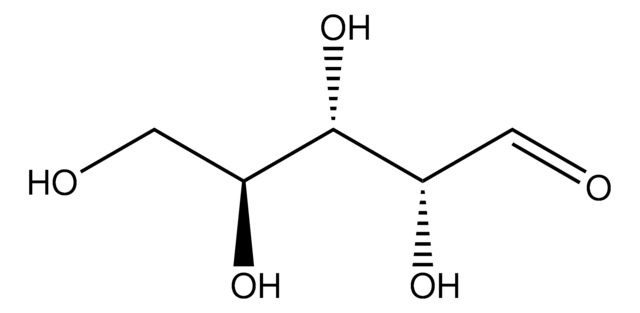X3877
D-(+)-Xylose
BioXtra, ≥99% (GC)
Sinonimo/i:
D-xylopyranose
About This Item
Prodotti consigliati
Nome Commerciale
BioXtra
Livello qualitativo
Saggio
≥99% (GC)
Stato
powder
tecniche
gas chromatography (GC): suitable
Impurezze
≤0.0005% Phosphorus (P)
≤0.1% Insoluble matter
Residuo alla calcinazione
≤0.1%
Colore
white
Intervallo di pH utile
6.0-6.5 (20 °C, 100 g/L)
Punto di fusione
154-158 °C (lit.)
Solubilità
H2O: 1 M, clear, colorless
Anioni in tracce
chloride (Cl-): ≤0.05%
sulfate (SO42-): ≤0.05%
Cationi in tracce
Al: ≤0.0005%
Ca: ≤0.0005%
Cu: ≤0.0005%
Fe: ≤0.0005%
K: ≤0.005%
Mg: ≤0.0005%
NH4+: ≤0.05%
Na: ≤0.005%
Pb: ≤0.001%
Zn: ≤0.0005%
Stringa SMILE
O[C@@H]1COC(O)[C@H](O)[C@H]1O
InChI
1S/C5H10O5/c6-2-1-10-5(9)4(8)3(2)7/h2-9H,1H2/t2-,3+,4-,5?/m1/s1
SRBFZHDQGSBBOR-IOVATXLUSA-N
Cerchi prodotti simili? Visita Guida al confronto tra prodotti
Applicazioni
- Structural and molecular insights into a bifunctional glycoside hydrolase 30 xylanase specific to glucuronoxylan: This study provides a detailed analysis of the enzyme′s structure and function, demonstrating D-(+)-Xylose′s role in enhancing our understanding of xylose metabolism in industrial applications such as biofuel production and biotechnological innovations (Pentari et al., 2024).
- Efficient production of 1,2,4-butanetriol from corn cob hydrolysate by metabolically engineered Escherichia coli: Highlights the utilization of D-(+)-Xylose from agricultural waste, optimizing processes for sustainable biofuel production, emphasizing the sugar′s pivotal role in renewable energy research (Li et al., 2024).
- Biochemical characterization of a xylose-tolerant GH43 β-xylosidase from Geobacillus thermodenitrificans: Provides insights into the enzyme′s biophysical properties and its utility in biotechnological applications, furthering the understanding of D-(+)-Xylose′s role in enhancing enzyme performance under various industrial conditions (Melo et al., 2023).
- Genome-scale metabolic modeling reveals metabolic trade-offs associated with lipid production in Rhodotorula toruloides: Explores how D-(+)-Xylose can be used to optimize metabolic pathways for improved lipid production, highlighting its potential in synthetic biology and metabolic engineering to enhance bioproduct synthesis efficiency (Reķēna et al., 2023).
Altre note
Codice della classe di stoccaggio
13 - Non Combustible Solids
Classe di pericolosità dell'acqua (WGK)
WGK 1
Punto d’infiammabilità (°F)
Not applicable
Punto d’infiammabilità (°C)
Not applicable
Dispositivi di protezione individuale
Eyeshields, Gloves, type N95 (US)
Scegli una delle versioni più recenti:
Possiedi già questo prodotto?
I documenti relativi ai prodotti acquistati recentemente sono disponibili nell’Archivio dei documenti.
I clienti hanno visto anche
Il team dei nostri ricercatori vanta grande esperienza in tutte le aree della ricerca quali Life Science, scienza dei materiali, sintesi chimica, cromatografia, discipline analitiche, ecc..
Contatta l'Assistenza Tecnica.








